Peter MALONE
Saturday, 18 September 2021 19:43
Silent Scream

SILENT SCREAM
US, 1980, 87 minutes, Colour.
Rebecca Balding, Yvonne de Carlo, Cameron Mitchell.
Directed by Denny Harris.
One of many low budget gory horror thrillers which were popular at the end of the 70's. Friday the 13th, B-horror thrillers achieved enormous popularity and high box office returns. Others, in the tradition of Hallowe'en, were also very popular. This trend was also seen in many A budget films such an Dressed To Kill. The material in this film in traditional - young students in an eerie house, a secret in the attic, a mad daughter and knife murders.
It iscompetently done. Yvonne de Carlo appears as the mother and Cameron Mitchell has a role as one of the policemen.
1. The appeal to audiences of this kind of gory horror thriller? The popularity of the trend in the 70s? Nightmare material? Audiences fascinated by knives and horror?
2. The conventions of the genre: innocent students, the threats and the students being menaced? The haunted and eerie house? The mysterious family? The secret in the attic? The culmination and violence? How well ware these presented here? Average, above average?
3. The atmosphere of the West Coast, university town. boarding accommodation, the house, the family? The beach sequences? The final emphasis on interiors? The musical score? The special effects especially for shock and suspense?
4. The slow motion opening with the police arriving? The audience wondering what had happened and who was involved? A device to keep audience attention throughout the film until the sequence was repeated at the end? The basic plausibility of the plot: the university students needing accommodation. the three types presented? Mrs Engles and her house? Mason and his manner? The discovery of the various killings? The police investigation? The confrontation with Victoria and Mrs Engles' secret? Is this kind of plot possible? Contrived for the purposes of the horror?
5. The focus on Scottie as heroine? The audience identifying with her? Her search for accommodation? The search of the house, the mysterious Mrs Engles and her room? Mason and his running the house, his hobbies? Friendship with Jack. Doris, Peter? The celebration, the walk along the beach, the discovery of Peter's killing? Her response to the police? Doris and her doing the laundry and the discovery of her death? Scottie and Jack. relationship, sexual? Their decision to discover the truth? Scottic (as heroine in this kind of film) searching the staircases of the house? The discovery of Victoria, the confrontation? The rescue and the death of Victoria? The shattering of Mrs Engels? A sufficient characterisation for a heroine of this kind of thriller?
6. The presentation of Jack as hero - conventional hero, foil to Scottic and helping her? His participation in the search? Peter and his being spoilt, murdered on the beach? Doris and the ugliness of her death?
7. Mrs Engels and her presence, her room, the mystery of the past? Brad and his introversion and the spying around the house?
8. Victoria and the background of her madness? The horror of her experience? The violence of her killing? The confrontation in the attic? Her strength? The pathos of her death?
9. The picture of the police - conventional investigation, confrontation at the end?
10. The basic themes of horror, menace, secrets, madness? Audience involvement in this kind of nightmare horror material?
Published in Movie Reviews
Published in
Movie Reviews
Tagged under
Saturday, 18 September 2021 19:42
Silent Partner, The
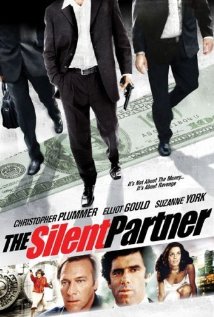
THE SILENT PARTNER
Canada, 1978, 106 minutes, Colour.
Elliott Gould, Christopher Plummer, Susannah York, Ken Pogue, John Candy.
Directed by Daryl Duke.
The Silent Partner is an interesting thriller. Elliott Gould is a bank teller who gets information that the bank is about to be robbed – and puts a lot of the money in his own personal account. The robber, finding that he hasn’t gained as much money as anticipated, is angry and pursues the teller. The film concentrates on the battle of wits between the two. With Gould as the teller, Christopher Plummer is the robber. Susannah York and John Candy are also in the cast.
The film was directed by Daryl Duke, Canadian director of films and television including I Heard the Owl Call My Name as well as the series of The Thorn Birds. The film was co-written by Curtis Hanson who later became much more famous with such films as The Bedroom Window, The River Wild and his Oscar-winning LA Confidential. The film is an adaptation and remake of a Danish film whose English title is Think About the Number.
1. The appeal of crime thrillers? Interest in robberies, criminals, action, identification with the basic situation? The prevalence of such robberies in the seventies? The conventions of this kind of thriller ? how well presented here?
2. Canadian production, atmosphere, Toronto?
3. The title and its significance? The interrelationship of Myles with Reikle? Julie being Myles’s silent partner at the end?
4. The importance of the initial Christmas set-up, the presentation of the bank, the shopping mall? Santa Claus and his writing, a note? His sinister presence and the way that he treated the children? The growing suspicions and Santa Claus watching the bank and Myles watching him? The irony of Myles's knowing the Santa Claus's intention? The
Build-up to the robbery and its effect?
5. The irony of Myles’ having the note, doing the planning, hiding the money? His execution of the plan? The importance of the revelation of the truth for Reikle? The tension then for Myles as Reikle would pursue him? plan to outwit Reikle?
6. Myles' character and Elliot Gould's appearance and performance? Seeing him in detail at home, taking Julie out and being uninteresting on a date, the talk about the fish? His shrewdness in hiding the money and putting it in the bank vault? Everybody underestimating him at every turn? The irony of the difficulties - the housekeeper cleaning out the refrigerator, the garbage truck? His schemes to recover his losses? The build-up in outwitting Reikle? The entry of Elaine into the picture, his suspicions, bond with her, sexuality, love? Her loyalty to him? His outwitting Reikle with following him home, getting him arrested and put in prison, getting the loyalty of Elaine, hiding her body, outwitting him with the money at the end? Audiences being on side with Myles’ ingenuity?
7. How well did Elliot Gould communicate the nuances of his character - when he was alone and his shyness, the up and down relationship with Julie? The reactions on the television and his nervousness at the bank afterwards? The telephone calls and his reaction? His reaction to violence and the pursuit of Reikle? His activity in getting Reikle into prison and the identification line? His grief at Elaine's death? His being shot at the end? A credible bank teller? A credible character?
8. The film's presentation of the bank and its personnel, the ordinary bank, Julie and her work, Charles and his relationship with Julie, the fat teller and his attraction towards Louise, the man with the sexual design on Louise, Louise herself? The Christmas parties and the detail of interactions and tensions, affairs, Louise’s marriage and the celebration, lunch hours etc.?
9. Christopher Plummer's style as Reikle? As Santa Claus, in the robbery, his brutality to the girl during the massage, his phone calls and menace towards Myles, breaking into his room, his being outwitted and followed homo, on the line-up and his going to prison, the visits from Elaine in prison and his hold over her, the final confrontation with her and the brutality of his murdering her, his following Myles at the foundation site of the building, the build-up to the final robbery and his death? An effective portrait of a criminal?
10. Susannah York as Julie, presence in the bank, available type, her puzzle with the dates with Myles, his taking her home, the advances and then the break-off, her resentment, her fascination, the fact that she looked inside the bag and would share his dream?
11. The background theme of Myles’ father, his visit to him during the Christmas Carols? The funeral sequence? Elaine and her presence, her story, her turning up? The visit to the night club? Her work there? The bond between the two and her decision to double-cross Reikle? Her loyalty to Myles at the end? Audience expecting her to die, reaction to her death?
12. How well did the film present an atmosphere of menace, mutual stalking, outwitting people? Quick thinking? The humour of the ending and Myles winning out against Reikle?
13. The amorality of the ending? The jolt to conventional values? Audience sympathy for the characters, for the crime? Myles appearing less criminal In comparison with Reikle and being allowed to keep the money?
Published in Movie Reviews
Published in
Movie Reviews
Tagged under
Saturday, 18 September 2021 19:42
Silent Friends/ Dogs to the Rescue

SILENT FRIENDS (DOGS TO THE RESCUE)
Canada/Romania, 1969, 84 minutes, Colour.
Melania Carje, Iona Casetti, Dorin Dron.
Directed by Paul Fritz Nemeth and Gheorghe Turcu.
Silent Friends is a collaboration between Canada and Romania. It is a children’s film, focusing on children and dogs. The main adventures concern the dogs and a baby – with a blend of serious themes as well as some comedy for the younger audiences.
1. Was this a good children’s film? What are the qualities for a good children's film? For interest, entertainment cinematic techniques?
2. The main interest in this film, its appeal?
3. The interest for children in the basic situation? The clash of good and bad characters at the start? Cruelty? Danger for children? Dogs, the baby? The journey and the quest? Comedy? How well combined were these ingredients?
4. The picture of the adults? The initial quarrelling and violence? Alex and his friend as villains? The initial accident? The contrast with Maria and her friend? The children’s identification with the children in the film?
5. The impact of the chasing of the boy and his accident? His wanting to rescue the baby?
6. How attractive were the dogs? The presentation of their skill? The filming of them as if they were human? The emotional response to the dogs? Their concern for the baby, their skill in saving her?
7. The attractiveness of the baby? The credibility of these adventures for the baby? The parallel with the duck and the humour?
8. The heroism and comedy blend for the policeman and his nagging wife? The fact that the policeman solved the problem?
9. Coment on the quality of the adventures the dogs underwent? For the baby? In the countryside? In the hospital, on the mountains, on the lake and the boat?
10. How humorous was the comedy? Why?
11. How satisfying was the resolution? The villains caught, the policeman vindicated, the baby and the boy saved, the father found to be alive?
12. How well did the film explore values for children, especially loyalty and love, survival and concern?
Published in Movie Reviews
Published in
Movie Reviews
Tagged under
Saturday, 18 September 2021 19:42
Signpost to Murder
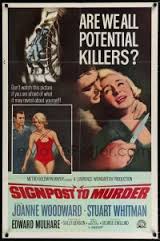
SIGNPOST TO MURDER
US, 1964, 75 minutes, Black and white.
Stuart Whitman, Joanne Woodward, Edward Mulhare, Alan Napier.
Directed by George Englund.
Signpost to Murder is a very brief thriller, quite effective in its way. Filmed in black and white, it has Stuart Whitman as a man escaped from a mental institution who hides out, threatening a young woman played by Joanne Woodward. British Edward Mulhare plays the doctor, Alan Napier the vicar.
The film was directed by producer George Englund who also made a number of interesting films including The Ugly American and A Christmas to Remember. As a curiosity item it can be added that the film was remade in 1969 in Hindi as Ittefaq.
1. The significance of the title? Did it offer a clue to the solution and the themes?
2. The structure of murder mysteries? Why do they appeal to audiences? The nature of the puzzle? Were enough clues given, the villain too evident?
3. How did the film rely on the audience reaction to murders, to madness, to escape, terrorizing, the need for survival, betrayal? were these ingredients well organised in this murder mystery?
4. The initial emphasis on the asylum, opening up the asylum life, the use of the wall, the warders and doctors, the need for getting out? The nature of life, Alex Forrester? The good side, the need to get out?
5. How was this well contrasted with the village? Its look, the role of the police, the people passing by the asylum, the vicar and his wife?
6. Did this film develop its characters well? Or were they merely for the murder mystery?
7. How much insight into the character of Alex Forrester? Initial impressions, his relationship with the doctor, the explanation of his background and type? His fear and suffering? Audience reaction to his violence and escape? His gentleness with Molly? Audience response when they discovered he had been used? The effect of the whole experience on him? What was he left with at the end?
8. The initial response to the doctor? How plausible and ernest? His relationship with Alex? The clues in his visiting Holly? Audience response to the ingenious set-up? The plan? His madness and Molly's betrayal of him at the end ( giving doctors a bad name? )?
9. Molly as heroine? The first sight of her in the swimming costume? The ultimate discovery how contrived this was? Her ability in acting the part? Leading Alex on? The nature of the truth? The reaction of all the events on Molly? The person of Alex changing her theoretical plans? Why did she kill herself?
10. Comment on the minor characters and their contribution to the atmosphere of the film and its themes. The doctors and their discussion about paroles and cures? The police and their investigations?
11. How well explored in a murder mystery were the basic themes of greed, love, lust, selfishness, power over others, poor use of others?
Published in Movie Reviews
Published in
Movie Reviews
Tagged under
Saturday, 18 September 2021 19:42
Siege at Red River, The
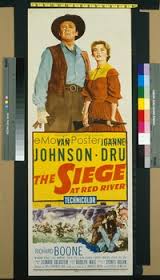
THE SIEGE AT RED RIVER
US, 1954, 86 minutes, Colour.
Van Johnson, Joanne Dru, Richard Boone.
Directed by Rudolph Mate.
The Siege At Red River is an average entertaining western, set in the Civil War with its atmosphere, also incorporating cavalry and Indians and problems with gattling guns. Directed by former photographer, Rudolph Mate, who made at this time such adventures as the Black Shield of Falworth. It has Van Johnson in an unusual western role. Richard Boone, later to be a villain in so many films and television series, plays a very mannered villain. Entertaining and quite interesting popular western material.
1. How interesting and entertaining a Western? The west itself, the background of the Civil War and espionage, ammunition and guns for the Indians, cavalry and Indian clashes?
2. How much did the film rely on the conventions of the western; sides in the Civil War, the pursuit of the cavalry, hero being ambiguous, heroine? Comedy sidekick? Scowling villain, Indians, sieges?
3. The importance of colour photography? Locations, sets, music? The special effects especially in the initial robbery, the songs and dances as the code for the spies, the final siege especially with the machine gun?
4. How credible was the plot? As a Civil War story. story of the American West? Jim Farraday and hie background in the Southern Army, posing as a salesman, his mission to get the Gatling gun to the army? His disguises and his techniques? The encounter with Nora and their falling in love and her attitudes towards cowards? The military pursuit? Manning and his double dealing? Ordinary story of the American Weet?
5. Van Johnson’s style as Jim Farraday? An engaging hero, the ambiguity of his staging the robbery at the beginning, his style as a salesman, his codes? Audience sympathy for the North instead of the South? His explanation of himeelf? The discussions about war, loyalties, right and wrong? His attraction towards Nora? His working well with Benji and his reaction to Benji’s death? The clashes with Manning yet relying on him? Pursuit of Manning, the capture by the militaryy his, helping them in the recuperation of the gun, his final escape? A credible western hero, his values?
6. The presentation of the military? Kelso and his pursuit of Farraday and his carrying out of his duty? His assistance? The expresentation of the military, their loyalties, techniques? The final siege? The contrast with Manning and his lack of loyalties, his brutality to the saloon girl, his deals with Farraday, his gambling and violence, his betrayal of Benji and killing him, his betrayal to the Indians? A violent ugly man of the west?
7. Nora as a vigorous heroine? The initial presentation with the wagon. her work as a doctor, place in the town, attitudes towards Farraday, disgust with him, his using her wagon for transportation of the gun, the adventures with him and beginning to trust him, the finale? The satisfying heroine?
8. The minor characters, Benji and his style, comedy? The people in the towns, the contacts - the note in the song, the buying of the bottle, the particular personalities spying? The picture of the ordinary people of the west buying the medicine?
9. Themes of loyalties, the Civil War and its issues, the effect on people and their clashes? The violence of one American against the other especially the memories of battles and death? The uniting against the Indians?
10. The portrayal of the Indians - how fairly, representing the times, understanding the Indians and the conflicts with the whites?
11. How satisfying a western, a picture of an aspect of America, understanding America and its heritage?
Published in Movie Reviews
Published in
Movie Reviews
Tagged under
Saturday, 18 September 2021 19:42
Siege
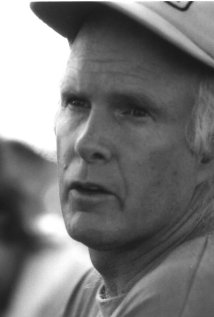
SIEGE
US, 1978, 100 minutes, Colour.
Martin Balsam, Sylvia Sidney, Dorian Harewood.
Directed by Richard Pearce.
A telemovie well above the average. It tells the frightening story of elderly citizens living alone in apartments in New York. While all are potential victims of robbers, muggers and people in general with violent tendencies, the aged are particularly open to this kind of attack. This story tells of some of the people who live in such an apartment, their being terrorized, their reactions - even to despair. It also tells of the stands that individuals take to safeguard themselves. Because of the anonymity of the attacks, the unwillingness of the elderly citizens to name names and give evidence for fear of reprisals and the limited resources of the police, the criminals go free. Points are very tellingly made in a strong screenplay which does not pull punches, especially for a television audience. There are excellent performances from Martin Balsam and from Sylvia Sidney in the leading roles. All in all, an exciting action police film. However, a much more serious social comment film.
1. An interesting and entertaining telemovie? A message film? how well did the film communicate its message - for the American audience, the audience of the cities, an older audience? Home audience? Its universal message?
2. The film's use of the conventions of the movie which introduces a range of people living in the one area their personalities, characteristics, interactions? how well were these used for the message of the film? The terrorising of neighbourhoods tradition? The police film? how well did the film use its conventions add to them?
3. Location photography in New York, an authentic atmosphere of the apartments, the streets, the park, the shops? Police precincts? The special effects for building up tension? The significance of the title?
4. How authentic did the plot seem? The portrait of elderly citizens? Their fears, loneliness? Phobias? Their being terrorised? The picture of young thugs and robbery, violence? The action and inaction of the police? The attitudes of the thugs towards the opposition of the elder citizens? The suicide of Mrs Gordon?
5. The basic message about elderly citizens, police protection, fears, phobias? Loneliness and irrational reaction? The need for some kind of security?
6. The picture of the thugs and their attacks - in the hallways, the elevators, the rooms, the methods of attack, the fears played on, the violence, the robberies? The helplessness of the older people? The action sequences and their persuasiveness?
7. Simon and his background? His promoting himself as king and the rituals which he went through? His young associates? His terrorizing the neighbourhood? His invasion of the flats, the rooms? The confrontation with Henry? The terrorizing of Mrs. Gordon? The police aid their inability to act? His defiance, the confrontation with Henry? How real a portrait of the thugs of the street?
8. Henry Fanchin - Martin Balsam's presence and style? A dignified old man, his background, place in the apartment, a widower, an ordinary citizen? His reaction to the attacks? The friendship with Lilian?
Their discussions about their lives? Facing old age, death? Henry and his wanting to take a stand? His seeking out Simon? The audience seeing Simon through Henry's eyes? The pleas for the police help? The attempts to help Lillian and their failure? His anger at her death? The confrontation? His courage, convictions? As a symbol for action that should be taken? The range of people unable to give evidence, fearful and yet supportive of Henry?
9. Lillian Gordon as representing the victims? The strength of her character, her life, fears? The importance of her ring and the lengths to which Henry went to get it back? his giving it back to her? The blossoming of their friendship? Her phobias and inability to cope? The continued invasions by Simon? The pathos and visual presentation of her suicide? Its impact on the audience? On Henry? Highlighting the desperate need for action?
10. The range of people in the neighbourhood. their refusal to give testimony, their wanting to give information but Simon's terrorising them? Their fears being justified? Their vindictive attitudes at the end confronting Simon?
11. A story of contemporary New York. of the contemporary cities? The film's comment on thuggery and terrorising in the streets. in liomest the plight of the aged? A valuable telemovie?
Published in Movie Reviews
Published in
Movie Reviews
Tagged under
Saturday, 18 September 2021 19:42
Sidekicks
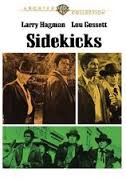
SIDEKICKS
US, 1974, 75 minutes, Colour.
Larry Hagman, Louis Gossett Jr, Blythe Danner, Jack Elam, Harry Morgan, Gene Evans, Noah Beery Jr.
Directed by Burt Kennedy.
Sidekicks is one of the many western comedies written by William Bowers and directed by Burt Kennedy. Bowers had begun writing thrillers in the 1950s but tended to specialist in comic westerns from the 1970s onwards including Support Your Local Sheriff, The Gun and the Pulpit, Kate Bliss and the Tickertape Kid. He collaborated with Burt Kennedy in many of these films for television. However, Kennedy had specialised in westerns from the 1950s and 60s including some classics like Welcome to Hard Times, The War Wagon, Support Your Local Sheriff.
The film is a variation on a theme, this time Larry Hagman in the west with sidekick Louis Gossett Jr (who was to win an Oscar some years later for An Officer and a Gentleman). Character actress Blythe Danner (mother of Gwyneth Paltrow) is the leading lady and veteran western and comic stars Jack Elam and Harry Morgan are in support. Humorous and entertaining.
1. An enjoyable comedy western?
2. The qualities of the film as a telemovie? As a sequel? The conventions of knockabout comedy, the conentions of the westenn? The significance of the title and the relationship between Quincey and his partner?
3. Colour location photography, comic music?
4. How enjoyable was the plot? A picaresque western? Following the adventures of the two, misunderstandings, their shrewd exploiting of situations, moneymaking, romance, happy ending?
5. The two sidekicks and their relating to one another, two conmen, the black and white theme? Their memories of the past, their bad luck, their exploiting situations, their loyalty to one another? Quincey and his fascination with Prudie? Their being caught up with the mastermind criminal? The humour and irony of their encounters with him and working for him? Their good luck in not being discovered? The irony of their being captured by the gamblers from the town? Their getting mixed up in so many different plots and their coming throughk them all? Two enjoyable comedy men of the west?
6. The character of Prudie and the ironic presentation of the heroine of the west, tongue-lashing, impulsive, quick with guns, preoccupied with hanging? Her father’s exasperation at her? Quincey's liking for her? The humour of the kidnapping, her continual taunting of them, their being vindicated at the end? An enjoyable comic performance?
7. The character of the sheriff and his easygoing running of the town, letting them go, arresting them, being Involved with Prudie and the whole plot? The main villain and his masterminding of things? The kidnappers taking the wrong pair from the prison? The gamblers and their attacking the two? The two criminals imprisoned, who made their escape? What kind of west was this and what kind of people?
8. Ordinary western themes of right and wrong, law and order, surviving in the west? The final build-up and shoot?out? The appropriate happy ending?
10. A fun western but using the conventions of the more serious western?
Published in Movie Reviews
Published in
Movie Reviews
Tagged under
Saturday, 18 September 2021 19:42
Sssnake

SSSNAKE
US, 1973, 99 minutes, Colour.
Strother Martin, Dirk Benedict, Heather Menzies, Richard B. Shull, Reb Brown.
Directed by Bernard L. Kowalski.
Sssnake anticipates a lot of the small-budget horror films of the mid-1970s, especially those influenced by animal menace films like Grizzly and Jaws.
The film begins rather calmly, a bit in the laboratory Frankenstein style. Strother Martin (who menaced Paul Newman in Cool Hand Luke) is a doctor experimenting with snake serums. A young man, played by Dirk Benedict of Battlestar Galactica, works as an assistant and is attracted to the doctor’s daughter. He is unaware that he is the target of the mad doctor’s experiment, using the serum to turn him into a king cobra. Once the transformation begins the horror starts.
The film was directed by Bernard L. Kowalski, a television director from the late 50s to the year 2000. He directed a few films for cinema including Stiletto and the last Cinerama film (with geographical inaccuracy), Krakatoa East of Java.
1. Indication of the title? The American title with its hissing? Expectations of science fiction. animal horror? The tone? Audience response to animal films, menacing animal films, the ecology interest of the 70's?
2. Humans versus animals and nature? Traditional animal horror and transformations? The from Walt Whitman, the critical outlook of the 70's about ecology?
3. The tradition of science fiction films and horror with the mad scientist and his playing God? An updated American variety? The touch of the tradition of circus sideshows and freaks?
4. How authentic the atmosphere of the film, realism? Fantasy? Colour, music, laboratories, American settings, circus and sideshow, colleges? The importance of the special effects – especially David's peeling, Tim the snake man, David's ultimate transformation and the fight with the mongoose?
5. Hostile audience reaction to snakes, the traditional and biblical animal, venomous, poisonous? Blend of.horror and fascination? The way that snakes were introduced into this film? As the theme? The future of humans, cold-blooded? How credible was the plot, in terms of science, in terms of horror? How should it be seen as a macabre fable? With the conventions of a parable?
6. Dr Steiner as a type, the doctor, his appearance, his place in a university, in America? His philosophy of life, his speculations about the future, his obsession? The human side with his daughter, employment of David and his seeming friendship? The ugliness of the revelation of the disappearance of Tim and his becoming the snake man? His becoming more a horror figure as the film proceeded ? especially, revenge killing of Steve? His cruelty?
7. The encounter with Dr. Daniel and his imprisoning him and Dr. Daniel's death? The coldness and callousness of his experimentation with David? The inevitability of his own death? An appropriate retribution? The conventional mad doctor? Or a difference, well characterised or not? David as the hero assistant? An ordinary character – victim and her relationship with her father? Romance with David?
8. Suffering brutality from Steve? The bonds between them? The visit to the circus? The transformation with Steve’s attack and then his death? David and his peeling and hallucinations? her fear? David and the gradual change, the ultimate transformation and victimisation? How could audiences be horrified - especially by identifying with David and suffering the experience with him? Kristina and the human side of the plot?
Published in Movie Reviews
Published in
Movie Reviews
Tagged under
Saturday, 18 September 2021 19:42
Squirm
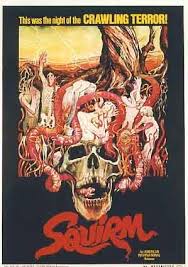
SQUIRM
US, 1976, 93 minutes, Colour.
Don Scardino, Patricia Pearcy, Peter Mac Lean.
Directed by Jeff Lieberman.
Squirm rhymes with worm. This is one of the low-budget horror films of the 1970s, a prolific genre with such films as Food of the Gods, Empire of the Ants and Lieberman’s own Blue Sunshine. It fitted into the pattern of animal menace, the most prominent example of which was Jaws (1975).
The film explains that worms can be brought to the surface by electricity. When there is an unusual storm in a southern town, the wires come down, the worms come to the surface – but, unfortunately for the population, many of whom are southern rednecks, the worms actually devour human beings.
This has been familiar horror material over the decades – and this is quite a well-made example of the 1970s versions.
1. The appeal of science fiction films, the interpretation of the present and the future? The appeal of horror as an aspect of science fiction? Ugliness and death, terror? the modern ecological approach? the upsets in nature and the effect on human beings?
2. The quality of this film as an example of ecological horror? The situation of the town, storm, electricity, the worms? The characters and the situations and the presentation?
3. How credible was the basic plot? the initial explanation with dates and places?
4. The film's creating of the atmosphere of Georgia, out of the way, the town itself and its isolation, the people and their unfriendliness? The atmosphere of the forests? The lack of welcome to the outsider? The film as a piece of Americana presenting the way of life in a small Georgia town?
5. The basic premise of the electricity going into the ground and its effect on the worms? The visualizing of the storm and the power lines, the worms?
6. The importance of the worms themselves? the microscopic photography during the credits? Their gradual appearance during the plot? The initial presentation of corpses and skeletons, the worms like leeches on the face of the man, their gradual coming out of the ground, their fleeing against the light, then their coming in their thousands and eating away the roots of the tree, their appearance in the house, thousands coming from behind the doors? Their attacks on the villains, on the mother?
7. What is the quality of audience horror at the visualising of worms and the shared imagination of their attacks? Squeamish, squirmish?
8. The characterisation for the credibility of the film, the mother, her relationship to her daughters, her fussing? The two girls, the older and her wanting to meet her boyfriend, competent etc.? The younger as idle, pleasure-seeking, marijuana? Their attitudes towards the town, towards their neighbours, the borrowing of cars and trucks etc.? The ordinariness of their way of life, a context for the horror?
9. How attractive was the heroine? An ordinary kind of girl, her role in the household, going to meet her boyfriend, sharing the dangers, coping with the dangers?
10. How interesting a character was the hero? An ordinary kind of young man, a city style, entering the town, the worm in his milk, the fact that he was not believed and the hostility of the sheriff and others? His quick thinking and ability to cope with the situation? His analysis of the skeleton's teeth? His going to get the wood and his being attacked by the villain? His coping with the worms? His rescue of his girl¬friend? How credible were his heroics?
11. The character of the sister, her helping, not disturbing the mother, with the skeleton, preparing the dinner, the irony of her hiding in the box and so escaping?
12. The brief portrayal of the sheriff and the attack on this type of arrogant authority figure? His disbelief? His liaison? The humour of their eating spaghetti? The way that he and the woman were killed in their bed?
13. The father and son and their hostilities? The worm farm? The fishing scene and the attack of the worms? The fact that the son did not die immediately but returned to terrorise the girl and her boy¬friend? His attack in the house and on the staircase?
14. The screenplay and the various crises with the worms and the way that these were handled? The house, the tree, the volume of the worms?
15. The use of this kind of horror film as a comment on ecological upsets?
Published in Movie Reviews
Published in
Movie Reviews
Tagged under
Saturday, 18 September 2021 19:42
Squire's Loves

SQUIRE'S LOVES
Switzerland, 1979, 100 minutes, Colour.
Directed by Wilfrid Bolliger.
A Swiss romantic comedy, beautifully photographed, using Swiss locations and elegance. It is a 19th century story of a squire who has never married. looking back over the memories of his life, inviting the women in his life - these have now married - to a dinner. Each thinks she is the only one invited. There are ironies when they all meet each other and have to decide whom the squire should marry.
The film is made with style, elegance, a leisurely pace. The cast is Swiss although there is a guest performance by Italian actress, Alida Valli as the squire's maid. An interesting example of Swiss film-making of the late seventies.
1. The attraction of period romantic comedy? Style and elegance? The leisurely humour, satire?
2. The colour photography, the decor, clothes, music? The atmosphere of the period and Swiss elegance?
3. The structure of the film: the story of Salomon - his arranging the day for the visit of the ladies, the memory of each of the ladies individually and the cumulative build-up of Salomon's life? The irony that he did not marry? The arrival of each of the ladies, the parallels in style of their arrival, introduction, meeting each other? Their discussion and choice about his marriage? Their leaving? The audience invited to participate in the experience, the gamesmanship?
4. A classic 19th century story adapted for the screen? The literary background of the story, the literary style of the film?
5. The portrait of Salomon - the squire and his position, middle age, the collusion with his maid and the plans for the ladies' visit? His memories, his dreams? Fantasy and reality? The five women in his life? His aunt and her influence? His friends? The decisions that he made and their reasons? Middle age, acting as squire, memories of his work as artist, the military training?
6. The atmosphere of humour, pranks? The servants and their work in preparing the banquet? Marianne and her preparation of the would-be bride? her control in the household?
7. What was Salomon left with at the end? The narrator's comment about his behaviour, the effect on him? Ilis looking at the day and its ending? A future?
8. The portrait of each of the ladies? their background, their attractiveness, their attraction towards Salomon, romance, their families, their unwillingness to commit themselves to Salomon? Salome, Figoura, Hildegard, Agleya, Barbara? The characteristies they had in common: beauty, position, the possibilities of being a squire's lady? Their romantic attitudes, coldness?
9. The picture of society, pastjimes, art, enjoyment, politics?
10. Marianne and the young maid as the options for Salomon's bride? The ladies and their discussions and what they revealed of themselves and their attitudes? Their final option? The joke being played on them with the young maid being a boy?
11. Gentle and satiric insight into human nature? The role of the sexes? The nature of romance, love, commitment? The atmosphere of regret at the end of the film?
Published in Movie Reviews
Published in
Movie Reviews
Tagged under